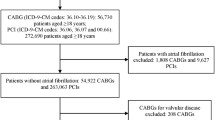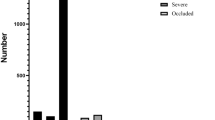Abstract
The CHA2DS2-VASc score predicts stroke and mortality risk in several cardiovascular diseases regardless of atrial fibrillation. In this study, we aimed to investigate the ability of CHA2DS2-VASc score to predict in-hospital and long-term outcomes in patients undergoing carotid artery stenting (CAS). The study population included 558 patients undergoing CAS. The patients were stratified into three groups based on their CHA2DS2-VASc scores [low (≤ 2, n = 123), moderate (3–5, n = 355) and high (6–8, n = 80)]. In-hospital and 3-year outcomes were compared between the groups. In-hospital rates of ipsilateral and major strokes and death were significantly different between the groups (1.6% vs. 3.9% vs. 16.2%; 1.6% vs. 4.5% vs. 16.2%; 0.8% vs. 3.1% vs. 13.8%, p < 0.001 for all, respectively). At 3 years of follow-up, rates of ipsilateral and major strokes and death were significantly increased in patients with highscore compared to those with moderate and low scores (1.6% vs. 5.8% vs. 13%, p = 0.005; 0.8% vs. 5.2% vs. 13%, p = 0.001; 1.6% vs. 8.4% vs. 15.9%; p = 0.002, respectively). After adjusting for multi-model Cox regression analysis, CHA2DS2-VASc score persisted as an independent prognostic factor for mortality and major stroke in patients undergoing CAS. Higher CHA2DS2-VASc score predicted increased risk of in-hospital and 3- year stroke and mortality in patients undergoing CAS.

Similar content being viewed by others
References
Mozaffarian D, Benjamin EJ, Go AS, Arnett DK, Blaha MJ, Cushman M, de Ferranti S, Després JP, Fullerton HJ, Howard VJ, Huffman MD, Judd SE, Kissela BM, Lackland DT, Lichtman JH, Lisabeth LD, Liu S, Mackey RH, Matchar DB, McGuire DK, Mohler ER III, Moy CS, Muntner P, Mussolino ME, Nasir K, Neumar RW, Nichol G, Palaniappan L, Pandey DK, Reeves MJ, Rodriguez CJ, Sorlie PD, Stein J, Towfighi A, Turan TN, Virani SS, Willey JZ, Woo D, Yeh RW, Turner MB, American Heart Association Statistics Committee and Stroke Statistics Subcommittee (2015) Heart disease and stroke statistics–2015 update: a report from the American Heart Association. Circulation 131:e29-322
Naylor AR, Ricco JB, de Borst GJ, Debus S, de Haro J, Halliday A, Hamilton G, Kakisis J, Kakkos S, Lepidi S, Markus HS, McCabe DJ, Roy J, Sillesen H, van den Berg JC, Vermassen F, Committee EG, Kolh P, Chakfe N, Hinchliffe RJ, Koncar I, Lindholt JS, Vega de Ceniga M, Verzini F, Reviewers EG, Archie J, Bellmunt S, Chaudhuri A, Koelemay M, Lindahl AK, Padberg F, Venermo M (2018) Management of atherosclerotic carotid and vertebral artery disease: 2017 Clinical Practice Guidelines of the European Society for Vascular Surgery (ESVS). Eur J Vasc Endovasc Surg 2018(55):3–81
Chaturvedi S, Sacco RL (2015) How recent data have impacted the treatment ofinternal carotid artery stenosis. J Am Coll Cardiol 65:1134–1143
Watanabe M, Chaudhry SA, Adil MM, Alqadri SL, Majidi S, Semaan E, Qureshi AI (2015) The effect of atrial fibrillation on outcomes in patients undergoing carotid endarterectomy or stent placement in general practice. J Vasc Surg 61:927–932
Kernan WN, Ovbiagele B, Black HR, Bravata DM, Chimowitz MI, Ezekowitz MD, Fang MC, Fisher M, Furie KL, Heck DV, Johnston SC, Kasner SE, Kittner SJ, Mitchell PH, Rich MW, Richardson D, Schwamm LH, Wilson JA, American Heart Association Stroke Council, Council on Cardiovascular and Stroke Nursing, Council on Clinical Cardiology, and Council on Peripheral Vascular Disease (2014) Guidelines for the prevention of stroke in patients with stroke and transient ischemic attack: a guideline for healthcare professionals from the American Heart Association/American Stroke Association. Stroke 45:2160–2236
Cohen DJ, Stolker JM, Wang K, Magnuson EA, Clark WM, Demaerschalk BM, Sam AD Jr, Elmore JR, Weaver FA, Aronow HD, Goldstein LB, Roubin GS, Howard G, Brott TG, CREST Investigators (2011) Health-related quality of life after carotid stenting versus carotid endarterectomy: results from CREST (Carotid Revascularization Endarterectomy Versus Stenting Trial). J Am CollCardiol 58:1557–1565
Kirchhof P, Benussi S, Kotecha D, Ahlsson A, Atar D, Casadei B, Castella M, Diener HC, Heidbuchel H, Hendriks J, Hindricks G, Manolis AS, Oldgren J, Popescu BA, Schotten U, Van Putte B, Vardas P, Agewall S, Camm J, Baron Esquivias G, Budts W, Carerj S, Casselman F, Coca A, De Caterina R, Deftereos S, Dobrev D, Ferro JM, Filippatos G, Fitzsimons D, Gorenek B, Guenoun M, Hohnloser SH, Kolh P, Lip GY, Manolis A, McMurray J, Ponikowski P, Rosenhek R, Ruschitzka F, Savelieva I, Sharma S, Suwalski P, Tamargo JL, Taylor CJ, Van Gelder IC, Voors AA, Windecker S, Zamorano JL, Zeppenfeld K (2016) 2016 ESC Guidelines for the management of atrial fibrillation developed in collaboration with EACTS. Eur J Cardiothorac Surg 50:e1–e88
Topaz G, Haisraely O, Shacham Y, Beery G, Shilo L, Kassem N, Pereg D, Cohen YK (2018) CHA2DS2-VASc score and clinical outcomes of patients with chest pain discharged from internal medicinewards following acute coronary syndrome rule-out. Clin Cardiol 41:539–543
Li CY, Chang CJ, Chung WJ, Lin CJ, Hsueh SK, Lee CH, Wu CJ, Tsai TH, Cheng CI (2018) Assessment of CHA2DS2-VASc score for predicting cardiovascular and cerebrovascular outcomes in acute myocardial infarction patients. Medicine (Baltimore) 97:e11230
Gök M, Kurtul A, Harman M, Kara M, Süleymanoglu M, Ornek E (2018) Relationshipbetween CHA2DS2-VASc score and rightventricular dysfunction in patients withacute pulmonary thromboembolism. Clin Appl Thromb Hemost 24:56S-62S
Rozenbaum Z, Elis A, Shuvy M, Vorobeichik D, Shlomo N, Shlezinger M, Goldenberg I, Kimhi O, Pereg D (2016) CHA2DS2-VASc score and clinical outcomes of patients with acute coronary syndrome. Eur J Intern Med 36:57–61
Orvin K, Bental T, Assali A, Lev EI, Assa HV, Kornowski R (2016) Usefulness of the CHA2DS2-VASC score to predict adverse outcomes in patients having percutaneous coronary intervention. Am J Cardiol 117:1433–1438
Ipek G, Onuk T, Karatas MB, Gungor B, Osken A, Keskin M, Oz A, Tanik O, Hayiroglu MI, Yaka HY, Ozturk R, Bolca O (2016) CHA2DS2-VASc Score is a predictor of no-reflow in patients with ST-segment elevation myocardial infarction who underwent primary percutaneous intervention. Angiology 67:840–845
Boulos NM, Gardin JM, Malik S, Postley J, Wong ND (2016) Carotid plaque characterization, stenosis, and intima-media thickness according to age and gender in a large registry cohort. Am J Cardiol 117:1185–1191
Sturlaugsdottir R, Aspelund T, Bjornsdottir G, Sigurdsson S, Thorsson B, Eiriksdottir G, Gudnason V (2016) Prevalence and determinants of carotid plaque in the cross-sectional REFINE-Reykjavik study. BMJ Open 6:e012457
Barnett HJM, Taylor DW, Haynes RB, Sackett DL, Peerless SJ, Ferguson GG, Fox AJ, Rankin RN, Hachinski VC, Wiebers DO, Eliasziw M (1991) Beneficial effect of carotid endarterectomy in symptomatic patients with high-grade carotid stenosis. N Eng J Med 325:445–453
Gonzales NR, Demaerschalk BM, Voeks JH, Tom ML, Howard G, Sheffet AJ, Garcia L, Clair DG, Barr J, Orlow S, Brott TG, CREST Investigators (2014) Complication rates and center enrollment volume in the carotid revascularization endarterectomy versus stenting trial. Stroke 45:3320–3324
Gray WA, Yadav JS, Verta P, Scicli A, Fairman R, Wholey M, Hopkins LN, Atkinson R, Raabe R, Barnwell S, Green R, CAPTURE Trial Collaborators (2007) The CAPTURE registry: predictors of outcomes in carotid artery stenting with embolic protection for high surgical risk patients in the early post-approval setting. Catheter CardiovascInterv 70:1025–1033
Khan M, Qureshi A (2014) Factors associated with increased rates of post-procedural stroke or death following carotid artery stent placement: a systematic review. J Vasc Interv Neurol 7:11–20
Aronow HD, Gray WA, Ramee SR, Mishkel GJ, Schreiber TJ, Wang H (2010) Predictors of neurological events associated with carotid artery stenting in high-surgical-risk patients. CircCardiovascInterv 3:577–584
Stingele R, Berger J, Alfke K, Eckstein HH, Fraedrich G, Allenberg J, Hartmann M, Ringleb PA, Fiehler J, SPACE investigators, Bruckmann H, Hennerici M, Jansen O, Klein G, Kunze A, Marx P, Niederkorn K, Schmiedt W, Solymosi L, Zeumer H, Hacke W (2008) Clinical and angiographic risk factors for stroke and death within 30 days after carotid endarterectomy and stent-protected angioplasty: a subanalysis of the SPACE study. Lancet Neurol 7:216–222
Kastrup A, Groschel K, Schulz JB, Nägele T, Ernemann U (2005) Clinical predictors of transient ischemic attack, stroke, or death within 30 days of carotid angioplasty and stenting. Stroke 36:787–791
Abu Rahma AF, DerDerian T, Hariri N, Adams E, AbuRahma J, Dean LS, Nanjundappa A, Stone PA (2017) Anatomical and technical predictors of perioperative clinical outcomes after carotid artery stenting. J Vasc Surg 66:423–432
Chan YH, Yiu KH, Lau KK, Yiu YF, Li SW, Lamet TH, Lau CP, Siu CW, Tse HF (2014) The CHADS2 and CHA2DS2-VASc scores predict adverse vascular function, ischemic stroke and cardiovascular death in high-risk patients without atrial fibrillation: role of incorporating PR prolongation. Atherosclerosis 237:504–513
Cinar T, Hayiroglu MI, Tanik VO, Aruğaslan E, Keskin M, Uluganyan M, Öz A, Çağdaş M, Alper AT (2018) The predictive value of the CHA2DS2-VASc score in patients with mechanical mitral valve thrombosis. J Thromb Thrombolysis 45:571–577
Satılmış S, Durmuş G (2020) Predictive accuracy of CHA2DS2-VASc score in determining the high thrombus burden in patients with non-ST-elevation myocardial infarction. Acta Cardiol 3:1–7
Puurunen MK, Kiviniemi T, Schlitt A, Rubboli A, Dietrich B, Karjalainen P, Nyman K, Niemelä M, Lip GYH, Airaksinen KEJ (2014) CHADS2, CHA2DS2-VASc and HAS-BLED as predictors of outcome in patients with atrial fibrillation undergoing percutaneous coronaryintervention. Thromb Res 133:560–566
Shuvy M, Zwas DR, Keren A, Gotsman I (2020) Value of the CHA2DS2 -VASc score for predicting outcome in patients with heart failure. ESC Heart Fail
Topaz G, Pereg D, Shuvy M, Mausbach S, Kimiagar I, Telman G, Kitay-Cohen Y, Vorobeichik D, Shlomo N, Tanne D (2017) Pre-admission CHA2DS2-VASc score and outcome of patients with acute cerebrovascular events. Int J Cardiol 244:277–281
Tanık VO, Aruğaslan E, Çınar T, Keskin M, Kaya A, Tekkeşin AI (2019) Association of the CHA2DS2VASc score with acute stent thrombosis in patients with an ST elevation myocardial infarction who underwent a primary percutaneous coronary intervention. Med Princ Pract 28:115–123
Author information
Authors and Affiliations
Contributions
All authors take responsibility for all aspects of the reliability and freedom from bias of the data presented and their discussed interpretation.
Corresponding author
Ethics declarations
Conflict of interest
All the authors declared that they have no conflict of interest.
Additional information
Publisher's Note
Springer Nature remains neutral with regard to jurisdictional claims in published maps and institutional affiliations.
Rights and permissions
About this article
Cite this article
Cerşit, S., Öcal, L., Keskin, M. et al. Usefulness of CHA2DS2-VASc Score to predict clinical outcomes of patients undergoing carotid artery stenting. Int J Cardiovasc Imaging 37, 783–789 (2021). https://doi.org/10.1007/s10554-020-02078-y
Received:
Accepted:
Published:
Issue Date:
DOI: https://doi.org/10.1007/s10554-020-02078-y




